Introduction
I use HDRI techniques to achieve an image that comes as close as possible to what my eyes saw in the scene when I shot it; a simple goal that can sometimes be more than a bit of work to achieve. To get a better idea of what HDR can do let’s take a look at how our eyes are able to see details in bright highlights and deep shadows at the same time.
Some Quick Definitions
Before we go any further let’s define a few of the terms used when discussing HDRI and our visual system:
High–dynamic-range imaging (HDRI or HDR) is a set of methods used in imaging and photography to capture a greater dynamic range between the lightest and darkest areas of an image than current standard digital imaging methods or photographic methods. HDR images can represent more accurately the range of intensity levels found in real scenes, from direct sunlight to faint starlight, and is often captured by way of a plurality of differently exposed pictures of the same subject matter.”
from…Wikipedia
- ⦁ HDRI (somtetimes shortened to HDR)……
- High dynamic range imaging or image.
- ⦁ Dynamic range (DR)……
- In photography, dynamic range describes the differences between the brightest and darkest parts of an image that still contain some detail. DR is measured in EVs (Exposure Value aka. ‘Stop’) an increase of one EV (or one stop) is a doubling of the level of brightness.
- ⦁ Contrast ratio……
- The difference between the lightest and darkest areas in a scene or image given as a ratio such as 100:1.
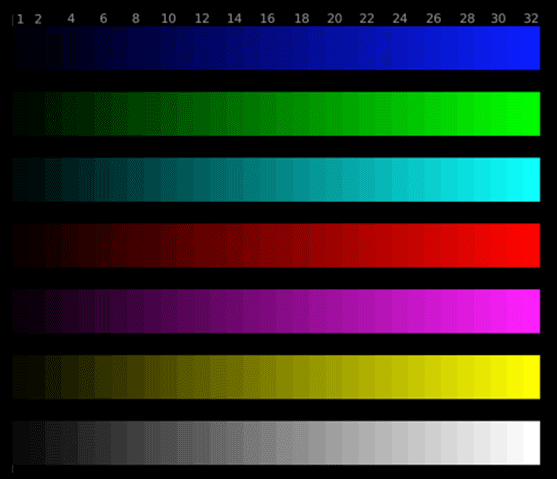
“The dynamic range test above illustrates how a display device can render a wide range of shades in a color spectrum. The more shades of color you see before they blend together shows you the dynamic range capabilities of the monitor you’re using.” Read more…
See, the essence of all imaging is light. Photography, cinematography, computer graphics— whatever imaging method you choose, light is always the central part. And HDRI is the ultimate digital representation of light. It can hold more light than any technology before, and it does it better than any other. To really understand the revolutionary concept, we have to go back and revisit how we perceive light.” Christian Bloch – “The HDRI Handbook 2.0”
Our Eyes — More Sensitive and Adaptive Than Any Camera
Our eyes are part of our brain; directly connected via the optic nerve to our visual cortex at the back of the brain. The optic nerve isn’t part of the central nervous system and it’s not affected by diseases that occur in the central nervous system. It’s not made up of the same types of nerve cells found elsewhere in the body; it’s made up of the same types of nerve cells found in the brain. Our eyes are the only exposed part of our brain. They are more sensitive and adaptable than any imaging system we have invented up to this point in history. But, HDR can come very close to reproducing their sensitivity.
The human eye is an incredible thing. In a single view it can differentiate contrasts up to 10,000 : 1. That’s a dynamic range of about 14 EVs. But it goes even further: the eye can adapt to almost any lighting situation, stretching the total perceivable range to approximately 1,000,000,000:1.”
Christian Bloch “The HDRI Handbook 2.0”
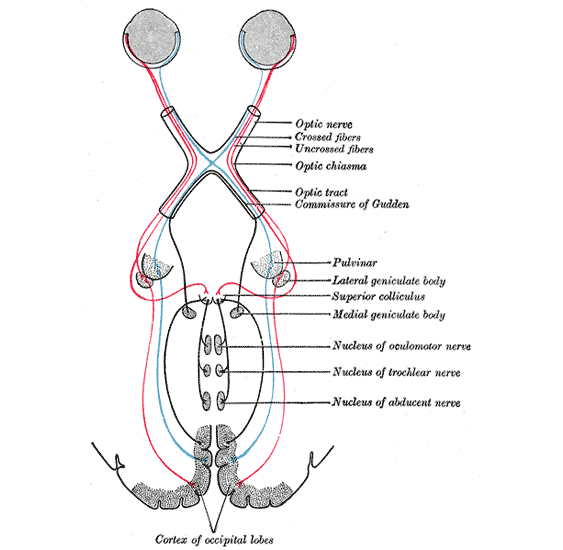
The optic nerve (also known as cranial nerve II) is a continuation of the axons of the ganglion cells in the retina. There are approximately 1.1 million nerve cells in each optic nerve. The optic nerve, which acts like a cable connecting the eye with the brain, actually is more like brain tissue than it is nerve tissue.”
“Anatomy, Physiology and Pathology of the Human Eye”
Seeing Dynamic Range In Art History
Our ability to see such a wide DR is very well demonstrated throughout Art History. For millennium painters have created paintings that reflect what they saw in the world around them; at the same time they very nicely illustrated how sensitive our visual system is.
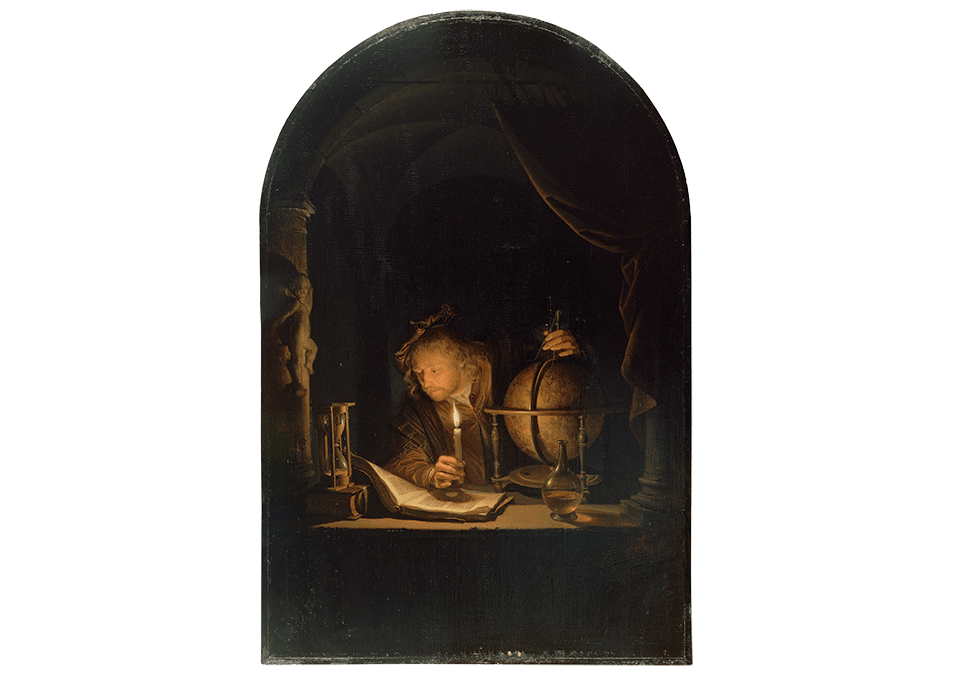
-
Here we see a beautiful illustration of artificial lighting before the age of the electric light. Look around the image and explore the scene. Notice the shapes and details in the background? Look at the details in the foreground objects on their shaded sides. The artist has painted this scene exactly as we would see it if we had been there. The single candle casts enough light to see well into the scene. But, no current consumer camera could capture the scene in a single exposure. For me this is exactly why I strive to capture the full dynamic range of a scene in my HDRI images.
I sometimes wonder if the ability of our eyes to adapt to dark scenes is any different than the eyes of those who lived before the bright artificial light we have today. Their eyes must have been well adapted to darkness before twilight was gone and full night had fallen. I suspect they were used to looking into very deep shadows and partially seeing, partially knowing and partially guessing what was there: something we dislike having to do in our age.
_-_Jules_Breton.png)
You’re looking at the three workers and directly into the setting sun. Even so you’re still able to see the three workers in detail. This is due to the adaptability of the eye and the brain’s processing of the visual information it’s receiving.
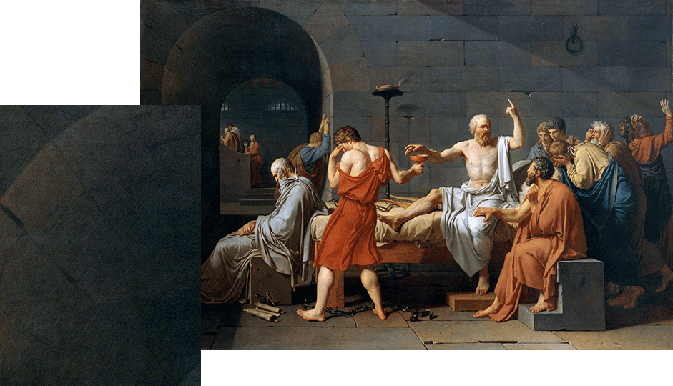
In this classical image we see the main figures in the foreground lighted by a large shaft of sunlight full of the detail we’d expect. Take a look at the detail insert I’ve added. The artist has included details in the deep shadow of the archway; again a situation that a camera can’t capture in a single exposure.
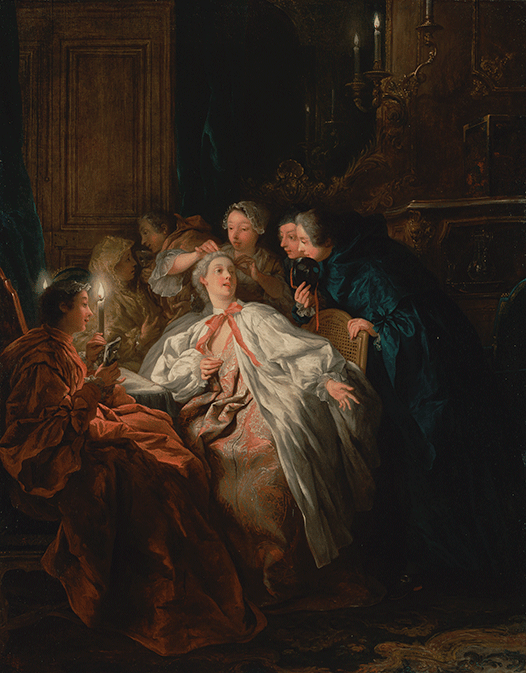
In this classical image we see the main figures in the foreground lighted by a large shaft of sunlight full of the detail we’d expect. Take a look at the detail insert I’ve added. The artist has included details in the deep shadow of the archway; again a situation that a camera can’t capture in a single exposure.
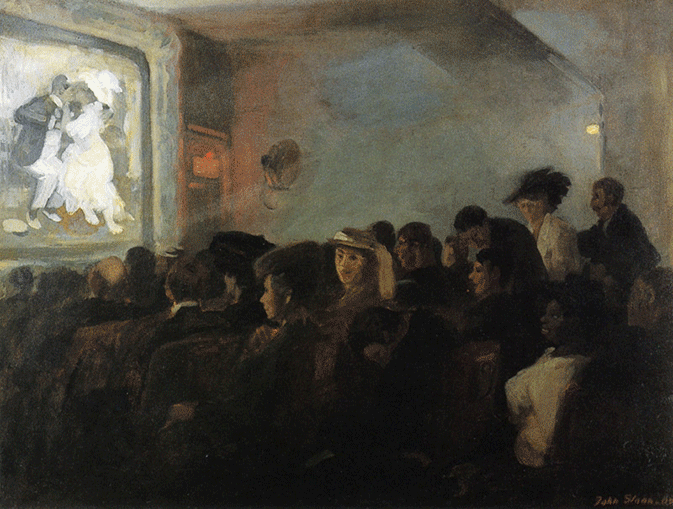
I don’t know how dark early 20th century movie theaters were, but I suspect the projection technology of the day didn’t light up the theater as much as today. Think about the last time you saw a movie in a theater; even though it was dark you were still able see the face of the person next to you, or even several rows away, at the same time you could see all the details of the image on the screen. A good example of the power of the eye’s adaptability and the brain’s processing power. Again, none of today’s cameras could capture what you were able to see with one exposure.
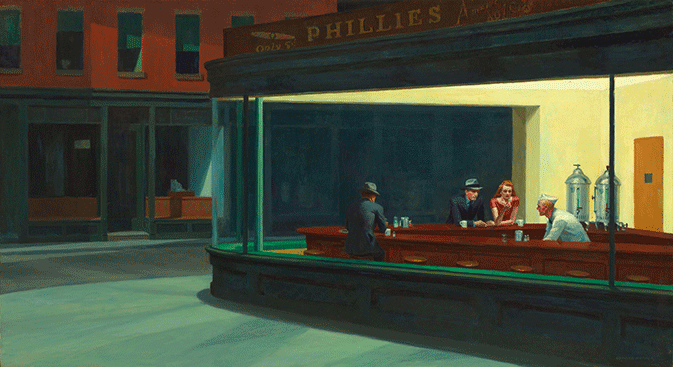
Ahh yes, Hopper’s masterpiece! This is a great example of a night scene in the electrical age. If you were standing in the scene you would, other than his colors, see it as he’s painted it. Even with the bright light of the diner you’d be able to make out the details in the darkened window of the storefront across the street. One exposure of a camera wouldn’t produce an image that would appear as you saw the scene.
“What Happens to Dynamic Range When Art Imitates Photography?”
Beginning in the late 1960’s and continuing today there’s been a ‘movement’ or ‘school’ of painting that uses photographic realism to communicate its message. “Photorealism” was at its height from the late 60’s through the mid-1970’s. It’s base was in the Bay Area and San Francisco in particular. I was a big fan at the time as a student in the Art Dept. at San Francisco State [University] mostly because the faculty was loaded with Photorealists at the time. But, I appreciated the craftsmanship of the technique mostly because I could never master it. “Hyperrealism” came along in the very early 21st century and incorporated even more technically difficult techniques.
So, why includ these two images in a discussion of DR in Art? Because they’re exceptions to the age old trend of painting images exactly or closely reflecting what the artist saw or would have seen in a scene.
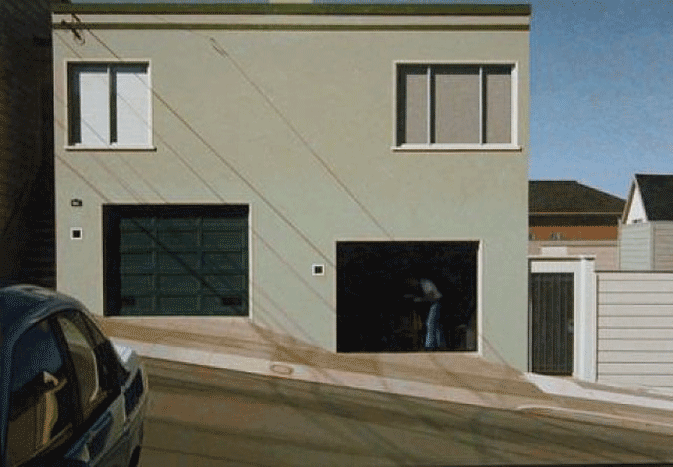
Robert Bechtle is known for his images of residential scenes in San Francisco. Like all the Photorealists he works from photographs of the scenes he paints, and that is exactly why his paintings contain a restricted DR. Take a look at the guy working in the garage across the street. If you were standing in the scene you’d be able to see most if not all of the details inside the garage, but given the overall DR of the scene a camera can’t capture the full range in a single exposure.
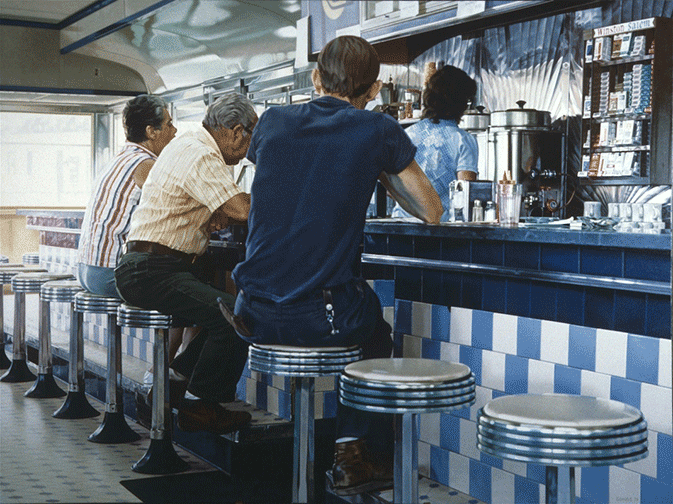
Ralph Goings is one of the founders of Photorealism, he’s known for his paintings of diner interiors and other still-lifes, he also works from photos. In this scene the camera’s exposure was set to capture the interior scene which caused the details outside the widow to be overcome by brightness. Of course our eyes would have been able to see those details.
A Short History of HDRI
Let’s move on to HDRI itself. As with any photographic technique or technical advancement HDRI has a history and an interesting one at that.
The Beginnings of HDRI
According to Wikipedia the first recognized attempt to overcome the issue of low DR in photography was done by Gustave Le Gray in the 1850’s. LeGray developed a technique we now call ‘combination printing’ in which he used separate negatives of the same scene taken with different exposures to produce a positive that contained more dynamic range than a single exposure could produce. Other photographers picked up and used this technique.
Probably the most well-known of the photographers using this technique was Henry Peach Robinson. He produced several top selling images using combination printing, two of which are below. In the first he shot six separate negatives to capture the dynamic range of the scene. In the second he shot and combined five negatives.

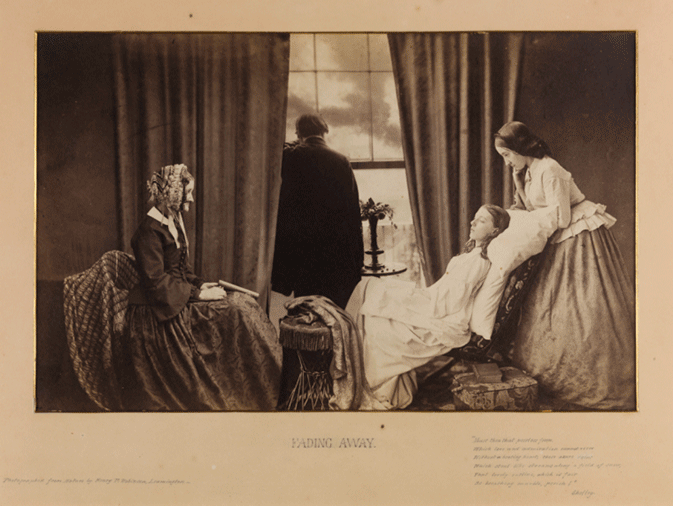
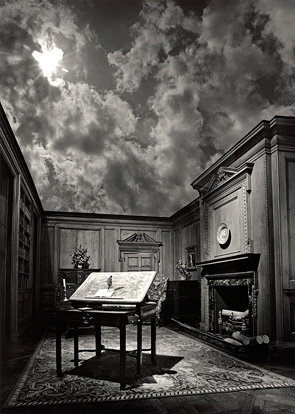
HDRI in The 20th Century
In the first half of the 20th century (1939-1940) Ansel Adams and Fred Archer developed the ‘Zone System’ which quickly became an important advancement in photographic techniques. “The Zone System is a photographic technique for determining optimal film exposure and development [based on a scale of shades ranging from 0 (black) to IX (white)].” Wikipedia


The first thing you need to know is that exposure meters are dumb, really dumb. They are clueless about what they’re photographing. They assume that all scenes have the same average tonal value –middle gray– roughly Zone 5 in the chart below. If a scene is different, for example a snow scene, it will be exposed incorrectly. It will come out middle gray: underexposed. If you follow the meter’s reading, every scene will have the same average middle gray density. You’ll get lots of bad exposures, especially if you photograph in difficult light. Ansel Adams developed the zone system to cope with this situation. His technique was to carefully study a scene, visualize the final print, then determine the correspondence between portions of the scene and tones in the print. He would then meter, expose and develop the negative accordingly. His basic rule was, ‘Expose for the shadows; develop for the highlights’.” The Luminous Landscape
A little over a decade after the Zone System appeared a very different situation requiring high dynamic range in an image arose: accurately recording what happens inside of a nuclear detonation in its first few seconds. In the late 1940’s and early 1950’s high speed photography was available but the massive DR of a nuclear fireball overwhelmed every photographic film of the time. A solution was needed, and quickly.
In the early 1950’s Charles Wyckoff developed a new type of photographic film that consisted of three layers of photosensitive emulsion each having a different level of sensitivity to light (aka. film speed), he called it ‘XR Film’. With it the very high dynamic range of a nuclear explosion could accurately be captured via high speed photography.
Below is a scan of a two page layout that appeared in Life magazine on December 23, 1966 showing a sequence of images of a nuclear explosion captured on Wyckoff’s XR film.
(Because of the quality of the scan I have redone the numbers for each image and have transcribed the text of the short article/caption that appeared below the image on the printed page. Also, the scan does not contain the colors that the author refers to in the text, but they can be inferred by the contrast in each frame.)
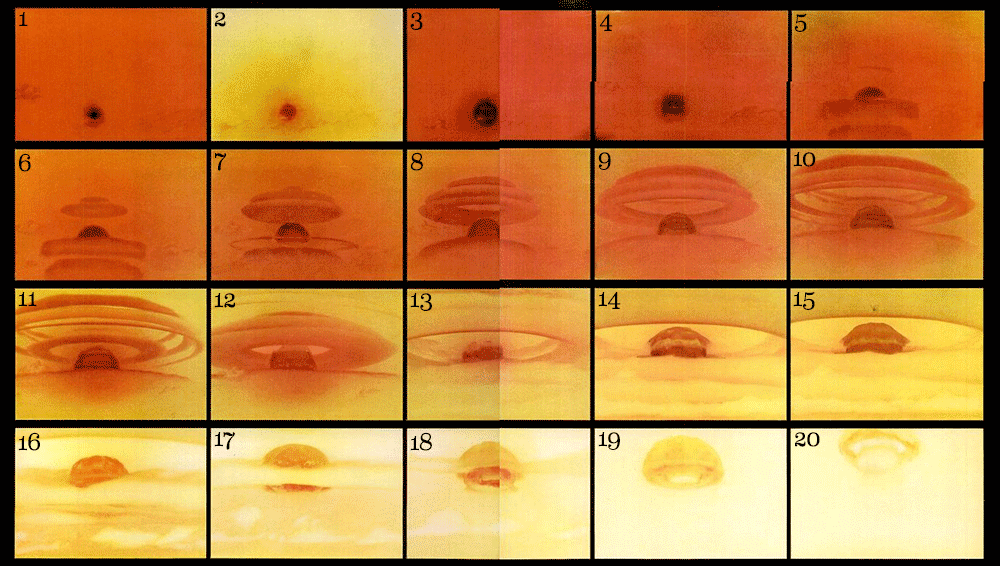
“These pictures of a nuclear blast were produced by an unusual type of film; nuclear explosions vary enormously in brightness, from the radiance of a thousand suns to the dimness of a luminous watch dial, a range no conventional film can record. Changes in the brightness indicate changes in temperature. To get accurate data on brightness and thus temperature during nuclear tests, Charles Wyckoff, of a research company called EG&G, Inc. devised a special film called “XR” for extended range. XR Film is comprised of three panchromatic layers: an extremely slow layer (color-coded cyan blue) to record the brightest phenomena; a medium-speed layer (magenta) for intermediate brightness; and a high-speed layer (yellow) for faint phenomena. These photographs show an explosion conducted by the AEC before the 1963 test ban treaty. The searingly hot 300,000 C fireball, recorded on the film’s slow layer at the start of the sequence, takes on-in the false-color code-a deep-bluish cast against a blood-red sky (1). As the fire-ball expands, it first (2) dims to red as it is obscured by opaque gases and then darkens again. In 5, expanding shock waves encounter moisture-laden layers of atmosphere creating rings of condensation which spread, rise and multiply. By 11, they are several miles in diameter. When the rising fireball reaches a cooler altitude, moisture freezes (14), capping the fireball with a cascade of ice. Finally, about a minute after detonation, nothing registers on the XR film but a yellow wisp (20) of radioactive cloud.”
HDRI in The Age Of Digital Images
XR Film remained the only form or HDRI medium, as primitive as it was, until the 1980’s when computing power began to grow exponentially. I began my life with computer hardware in 1987 and have witnessed this explosion of CPU power ever since.
In 1985 Gregory Ward created the first digital HDR image format which he called “Radiance RGBE image format” (Wikipedia and the “Radiance Synthetic Imaging System” site). Later his image file format was designated with the .hdr file extension. From this point HDRI grew quickly beginning with more and more techniques for ‘tone-mapping’ an HDR image.
HDRI as we commonly know it today in still photography consists of capturing multiple digital exposures of a scene each at a different shutter speed (thus each has a different overall exposure) and then combining them into a single image with much higher DR than any of them alone could contain. This process was first proposed by Steve Mann and Rosalind Picard in a 1995 paper. Mann went on to patent the process in 1998.
The history of HDR as we use it today starts in the digital age. Completely unnoticed by most of us, it had its first boom around 1997. In academic circles HDR was whispered about from door to door, traded as the new cool thing to write hot algorithms for. It was a revolutionary new way to deal with image data, and it was said to be your best chance to show your old professor that all he told you about digital images was bogus. In best renaissance tradition, students started discussing the nature of light again and how to represent it digitally. Along the way, this research had a dramatic impact on simulating light behavior and expressing it in render algorithms. Christian Bloch – “The HDRI Handbook 2.0”
- Visual Effects – Special FX – SFX…In films and television
- Paul Debevec “The Father of CGI”
- “The Art of HDR” An important ’05 history of HDRI in Film and TV
- Computer Generated Imagery (CGI)
- Computer Generated Animation
- HDRI in Videogames
- HDRI in Still Photography
How is HDRI Actually Used?
A Quick Note: As you might be able to tell I’m a BIG fan of Christian Bloch, the first editon of his book “The HDRI Handbook” (v2.0 is even better) was my major teaching and reference source as I learned HDRI. His website “HDR Labs” not only teaches the basics but keeps up with the quicly evolving world of HDRI, I highly reccomend it!